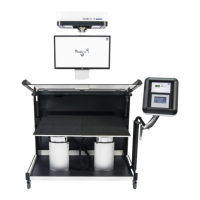Page 22 Operation Manual
A.4.2 Ambient Light
The Bookeye
®
4 location should have a controlled ambient light situation. The light
scenarios should avoid direct sunlight or spot light from light beams.
Also light sources that cause sharp shadows on the document on the book cradles or high
levels of ambient light could influence the scan result negative.
The Bookeye
®
4 scanner is an open system with a built-in high quality light source. Open
system means that the ambient light is added to the light seen by the camera.
Summary of a recommended location for a Bookeye
®
4 scanner:
• The location is not exposed to daylight.
• It is evenly illuminated from the ceiling with fluorescent lamps with electronic
ballasts. The light intensity measured on the book cradles should be approximately
300 lux.
• The light should not cause any shadows; therefore the variation of the intensity
across the scan area should be kept below 20%.
If the fluorescent lamps are powered by non-electronic ballasts, they will produce a flicker
twice the frequency of the main power supply (100Hz or 120Hz). If the intensity of this
light becomes too high, vertical stripes of even distances of approx. 8-12 pixels will be
visible on the scan.
Direct sunlight will vary over the day and will result in overexposed images. Sunlight can
also produce distinct shadows.
Light beams from spotlights will also produce distinct shadows. In most cases, they emit a
high level of infrared light. Infrared light is not visible to the human eye but to the camera.
The light source of the Bookeye
®
4 scanner itself has no infrared content at all, which
means that the scanner does not have an image quality degrading infrared filter. Too
much infrared content will result in overexposure.
The Bookeye
®
4 scanner has an integrated “White Balance” function. This function will
compensate ambient light influences. A “White Balance” calibration is recommended
when the light scenario has changed.

